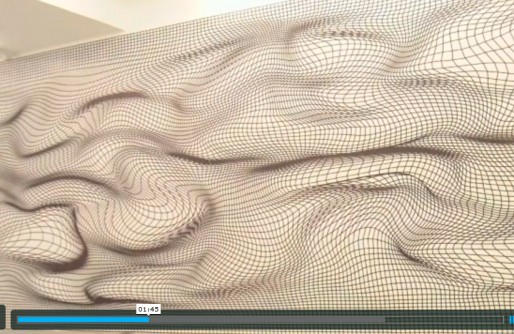23.4.2011 – 30.06.2011
Curator: Friederike Nymphius
“Don’t you wonder sometimes about sound and vision?” This question is recurrent in many moments of our life and even in a David Bowie song, also present in the exhibition named after another of his hits. Curator Friederike Nymphius conceived an international group show especially for Kunsthalle CCA Andratx that explores the notion of art, space and their interplay by challenging the visitor’s perception under the name of “Space Oddity”.
Strolling along the exhibition space in a new psychedelic reality, I couldn’t take the song out of my head and looked fascinated at the wall paintings like Peter Kogler’s 2001 untitled graphic images that seemed they were coming out from the wall and we could touch the reliefs. Terry Haggerty’s untitled 2011 wall painting also takes you into another dimension, and Bowie’s Space Oddity song came into my mind again: “even though I’ve crossed a hundred thousand miles, I’m feeling very still”
I move around this new realm of perception that reminds me of Foucault’s theory of Heterotopia, spaces that are present as an antithesis or an alternative to the space of the real world. At first it is not so evident in works like in Yago Hortal’s abstract expressionist acid colored canvas, but he composes new worlds, new realities, “a single drop creates space in the support” he explains. That idea brings out the curatorial contextualization intended by Friederike. There were many artists that are on the peak, like Martin Creed, who won the Turner Prize in 2001.
Looking at John Armleder’s light installation reminded me of Dan Flavin’s minimalists works, as the perception of space switch is immediately turned on. The viewer withdraws mentally from his environment and finds himself left alone in confrontation with the experience and its connotations. The sensible eye can sense the different color vibrations of the lights, but perception can only offer an illusion. The eye is fooled into dimensions that are not material but visual, it seems as if you can touch it.
A highly physical interaction is needed between the individual and the artwork, compelling the viewer to understand it not only through the mind, but also in terms of the body itself in space. It is a pure personal experience, a subjective response to the work, that means the work needs the spectator to exist. Armleder also goes into the pictorial with object from daily life on his mix media Some Flying Objects (Berlin Version), 1967-1975-2010, because we relate to these objects and construct our identity by accessing our memories and innermost feelings. To be aware of our perception is a subjective act, a symbolic process by which we construct our reality, our identity.
Our identity can also be constructed by abstract forms, because we relate to them in a different level, beyond logical reasoning, through our senses, like music, there lies the power of this kind of art. It is a conduct for reaching awareness. It is open for interpretations, it can be perceived differently by many people, that’s why it is the closest we get to universal art. Because it does not relate to any cultural or historical context, it doesn’t have any ideological limits. We can say this is a universal exhibition; it can be enjoyed by almost anyone, from kids to old age.

